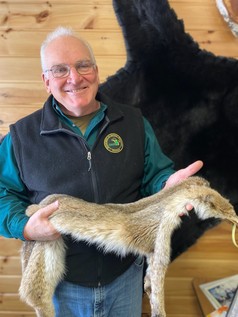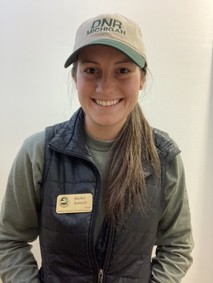|
Michigan has some of the best wildlife-based recreation opportunities around. This quarterly newsletter will give you updates on the great work going on for wildlife conservation across the state and some tips on how to get involved.
 DNR wildlife technician Rachel Kanaziz walks down the snow-covered Hunter’s Path at the Haymarsh State Game Area.
The Hunter’s Path at the Haymarsh State Game Area in Mecosta County is a 1.5-mile-long footpath looping through a growing forest. Wintertime hikes provide a unique view of the land without the green veil of vegetation. Winding across hilltops and valleys, the path offers scenic overlooks of the Featherbed Marsh and glimpses of wildlife foraging within the brush and soaring above the tall oaks.
To find the Hunter’s Path, enter the game area on 140th Avenue. Follow the Haymarsh Campground signs south along the road until 140th Avenue ends in a large parking lot by the Haymarsh Dam. A sign for Hunter’s Path marks the start of the trail.

Senior wildlife biologist Pete Kailing has been with the DNR Wildlife Division for 14 years. Based out of the Paris Field Office, he covers Mecosta, Newaygo and Oceana counties. When asked what his favorite part of working for the Wildlife Division is, Pete responded, “I frequently ponder our mission of fostering positive connections between people and wildlife and wild places. Boiling it down to daily tasks, being a ‘wildlife prophet,’ meaning, to simply share the truth about wildlife and wild places; an exciting, vibrant truth! Benefits include fresh air, birdsong, and people who care!"
|

Also at the Paris Field Office is new wildlife technician Rachel Kanaziz. Rachel has been with the Wildlife Division for four months, and so far, she has been inspired by the atmosphere of continuous learning and creative thinking that is often fostered through the diversity of staff backgrounds and the variety of tasks we tackle daily.
If you are interested in learning more about wildlife management or state game areas near you, contact your local wildlife biologist or email DNR-Wildlife@Michigan.gov.
|
 The 2021 Bear Forum was held in St. Ignace Dec. 17, 2021. DNR large carnivore specialist Cody Norton met with 20 stakeholders interested in black bear management to begin developing quota and regulation recommendations for the 2023-24 bear hunting seasons. Information shared to help inform discussions included preliminary 2021 harvest levels, population estimates, research and season updates, and trend indicators for each bear management unit.
Learn more about black bear management at Michigan.gov/Bear.
 Each year, leafless trees and frozen landscapes make winter a great time to glimpse the large, magnificent snowy owl.
Snowy owls breed in the Arctic, where they primarily eat lemmings, a small rodent. During their time in Michigan, they eat a variety of prey including rats, muskrats, waterfowl and fish. You can find snowy owls across the state in open areas such as fields and shorelines. Snowy owls like to perch in conspicuous places, and can often be found by scanning high points like hilltops, fence posts and rooftops on the landscape.
Here are a few quick tips for viewing these birds, while helping to keep them stress-free and safe: best practices for snowy owl viewing.
|